Aboriginal Cultural Tours in Japan
VerifiedAdded on 2023/01/23
|20
|4014
|39
AI Summary
This report examines the potential of promoting South Australian aboriginal cultural tours in Japan. It analyzes the PESTEL factors of Japan to understand the strengths and opportunities for international expansion. The report explores the political, economic, social, technological, environmental, and legal factors in detail.
Contribute Materials
Your contribution can guide someone’s learning journey. Share your
documents today.

Running head: ABORIGINAL CULTURAL TOURS IN JAPAN
Aboriginal Cultural Tours in Japan
Name of the Student:
Name of the University:
Author Note:
Aboriginal Cultural Tours in Japan
Name of the Student:
Name of the University:
Author Note:
Secure Best Marks with AI Grader
Need help grading? Try our AI Grader for instant feedback on your assignments.

1ABORIGINAL CULTURAL TOURS IN JAPAN
EXECUTIVE SUMMARY
The primary objective of the particular report is to study the structure of Japan to estimate the
strengths and opportunities the South Australian aboriginal tourism department has to
promote its product and services internationally. In this connection, the report critically
studies the PESTEL factors of Japan that helps the report to understand the potentialities of
business in Japan. The report examines each element of the PESTEL analysis in detail and
therefore estimates whether the same is a strength and opportunity for the Australian
department or not.
EXECUTIVE SUMMARY
The primary objective of the particular report is to study the structure of Japan to estimate the
strengths and opportunities the South Australian aboriginal tourism department has to
promote its product and services internationally. In this connection, the report critically
studies the PESTEL factors of Japan that helps the report to understand the potentialities of
business in Japan. The report examines each element of the PESTEL analysis in detail and
therefore estimates whether the same is a strength and opportunity for the Australian
department or not.

2ABORIGINAL CULTURAL TOURS IN JAPAN
Table of Contents
Introduction................................................................................................................................3
PESTEL analysis - Japan’s business environment.....................................................................3
Political..................................................................................................................................4
Economic................................................................................................................................6
Social......................................................................................................................................8
Technological.........................................................................................................................9
Environmental......................................................................................................................11
Legal.....................................................................................................................................13
Recommendations....................................................................................................................16
Conclusion................................................................................................................................16
References................................................................................................................................17
Table of Contents
Introduction................................................................................................................................3
PESTEL analysis - Japan’s business environment.....................................................................3
Political..................................................................................................................................4
Economic................................................................................................................................6
Social......................................................................................................................................8
Technological.........................................................................................................................9
Environmental......................................................................................................................11
Legal.....................................................................................................................................13
Recommendations....................................................................................................................16
Conclusion................................................................................................................................16
References................................................................................................................................17
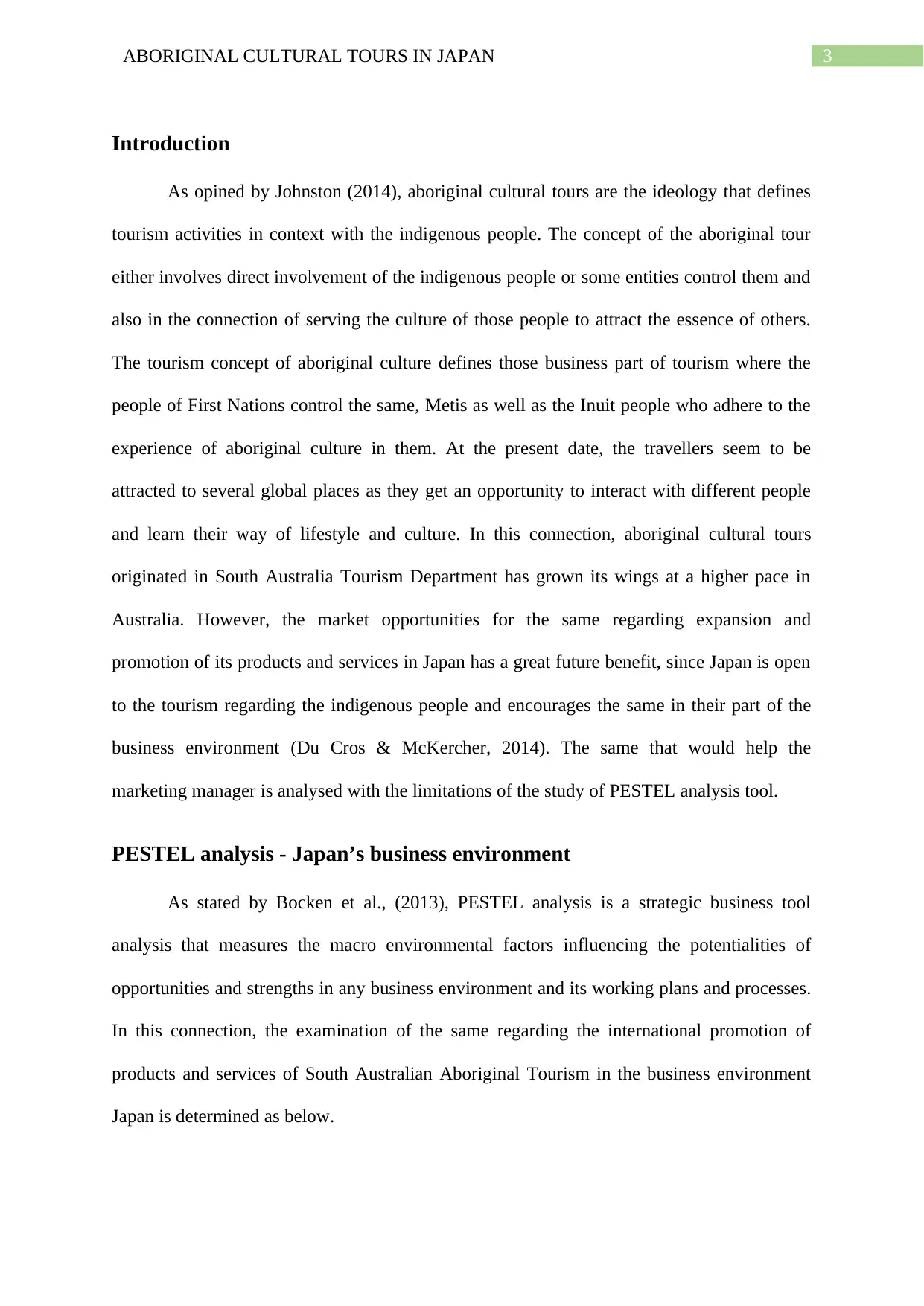
3ABORIGINAL CULTURAL TOURS IN JAPAN
Introduction
As opined by Johnston (2014), aboriginal cultural tours are the ideology that defines
tourism activities in context with the indigenous people. The concept of the aboriginal tour
either involves direct involvement of the indigenous people or some entities control them and
also in the connection of serving the culture of those people to attract the essence of others.
The tourism concept of aboriginal culture defines those business part of tourism where the
people of First Nations control the same, Metis as well as the Inuit people who adhere to the
experience of aboriginal culture in them. At the present date, the travellers seem to be
attracted to several global places as they get an opportunity to interact with different people
and learn their way of lifestyle and culture. In this connection, aboriginal cultural tours
originated in South Australia Tourism Department has grown its wings at a higher pace in
Australia. However, the market opportunities for the same regarding expansion and
promotion of its products and services in Japan has a great future benefit, since Japan is open
to the tourism regarding the indigenous people and encourages the same in their part of the
business environment (Du Cros & McKercher, 2014). The same that would help the
marketing manager is analysed with the limitations of the study of PESTEL analysis tool.
PESTEL analysis - Japan’s business environment
As stated by Bocken et al., (2013), PESTEL analysis is a strategic business tool
analysis that measures the macro environmental factors influencing the potentialities of
opportunities and strengths in any business environment and its working plans and processes.
In this connection, the examination of the same regarding the international promotion of
products and services of South Australian Aboriginal Tourism in the business environment
Japan is determined as below.
Introduction
As opined by Johnston (2014), aboriginal cultural tours are the ideology that defines
tourism activities in context with the indigenous people. The concept of the aboriginal tour
either involves direct involvement of the indigenous people or some entities control them and
also in the connection of serving the culture of those people to attract the essence of others.
The tourism concept of aboriginal culture defines those business part of tourism where the
people of First Nations control the same, Metis as well as the Inuit people who adhere to the
experience of aboriginal culture in them. At the present date, the travellers seem to be
attracted to several global places as they get an opportunity to interact with different people
and learn their way of lifestyle and culture. In this connection, aboriginal cultural tours
originated in South Australia Tourism Department has grown its wings at a higher pace in
Australia. However, the market opportunities for the same regarding expansion and
promotion of its products and services in Japan has a great future benefit, since Japan is open
to the tourism regarding the indigenous people and encourages the same in their part of the
business environment (Du Cros & McKercher, 2014). The same that would help the
marketing manager is analysed with the limitations of the study of PESTEL analysis tool.
PESTEL analysis - Japan’s business environment
As stated by Bocken et al., (2013), PESTEL analysis is a strategic business tool
analysis that measures the macro environmental factors influencing the potentialities of
opportunities and strengths in any business environment and its working plans and processes.
In this connection, the examination of the same regarding the international promotion of
products and services of South Australian Aboriginal Tourism in the business environment
Japan is determined as below.
Secure Best Marks with AI Grader
Need help grading? Try our AI Grader for instant feedback on your assignments.
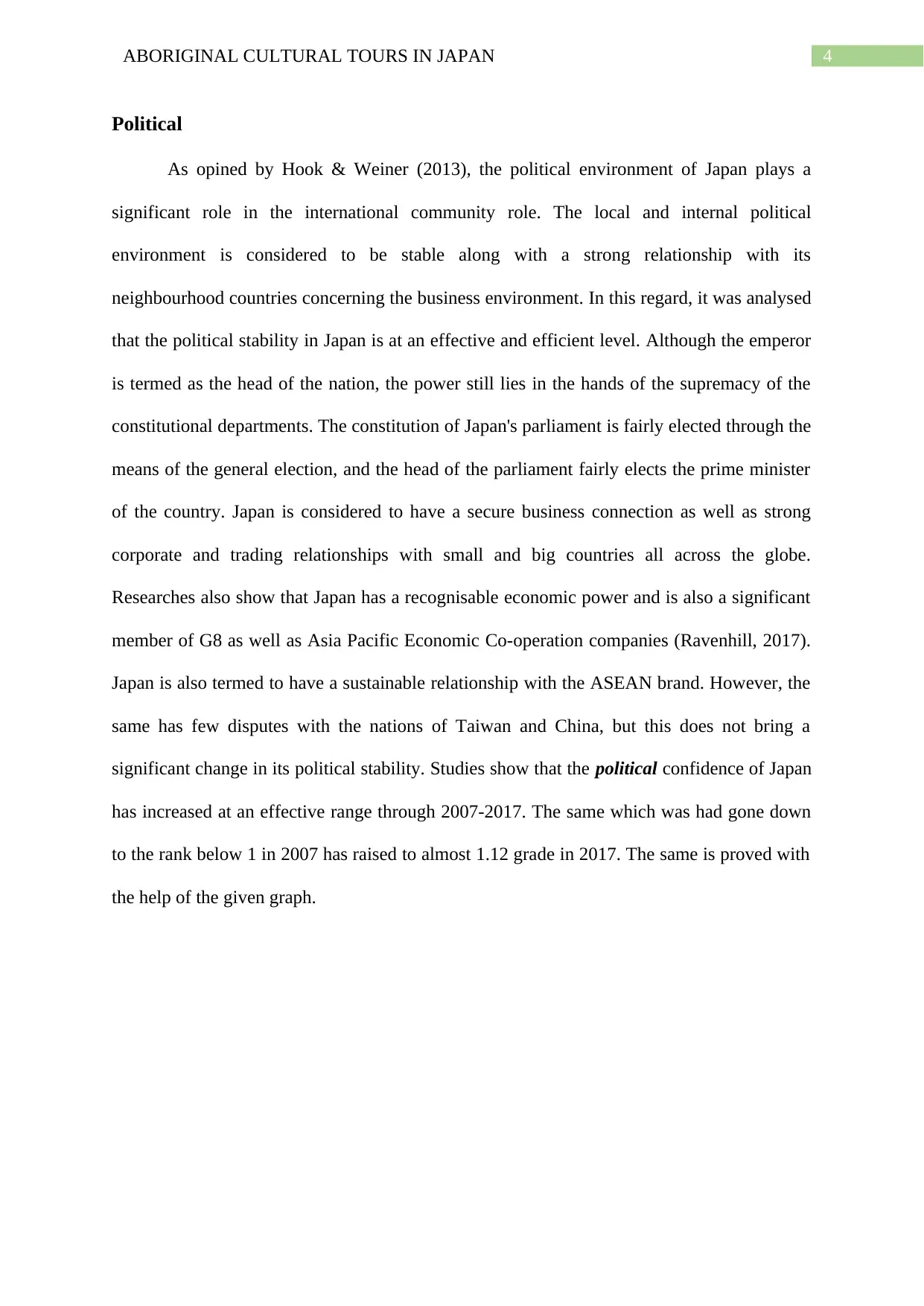
4ABORIGINAL CULTURAL TOURS IN JAPAN
Political
As opined by Hook & Weiner (2013), the political environment of Japan plays a
significant role in the international community role. The local and internal political
environment is considered to be stable along with a strong relationship with its
neighbourhood countries concerning the business environment. In this regard, it was analysed
that the political stability in Japan is at an effective and efficient level. Although the emperor
is termed as the head of the nation, the power still lies in the hands of the supremacy of the
constitutional departments. The constitution of Japan's parliament is fairly elected through the
means of the general election, and the head of the parliament fairly elects the prime minister
of the country. Japan is considered to have a secure business connection as well as strong
corporate and trading relationships with small and big countries all across the globe.
Researches also show that Japan has a recognisable economic power and is also a significant
member of G8 as well as Asia Pacific Economic Co-operation companies (Ravenhill, 2017).
Japan is also termed to have a sustainable relationship with the ASEAN brand. However, the
same has few disputes with the nations of Taiwan and China, but this does not bring a
significant change in its political stability. Studies show that the political confidence of Japan
has increased at an effective range through 2007-2017. The same which was had gone down
to the rank below 1 in 2007 has raised to almost 1.12 grade in 2017. The same is proved with
the help of the given graph.
Political
As opined by Hook & Weiner (2013), the political environment of Japan plays a
significant role in the international community role. The local and internal political
environment is considered to be stable along with a strong relationship with its
neighbourhood countries concerning the business environment. In this regard, it was analysed
that the political stability in Japan is at an effective and efficient level. Although the emperor
is termed as the head of the nation, the power still lies in the hands of the supremacy of the
constitutional departments. The constitution of Japan's parliament is fairly elected through the
means of the general election, and the head of the parliament fairly elects the prime minister
of the country. Japan is considered to have a secure business connection as well as strong
corporate and trading relationships with small and big countries all across the globe.
Researches also show that Japan has a recognisable economic power and is also a significant
member of G8 as well as Asia Pacific Economic Co-operation companies (Ravenhill, 2017).
Japan is also termed to have a sustainable relationship with the ASEAN brand. However, the
same has few disputes with the nations of Taiwan and China, but this does not bring a
significant change in its political stability. Studies show that the political confidence of Japan
has increased at an effective range through 2007-2017. The same which was had gone down
to the rank below 1 in 2007 has raised to almost 1.12 grade in 2017. The same is proved with
the help of the given graph.
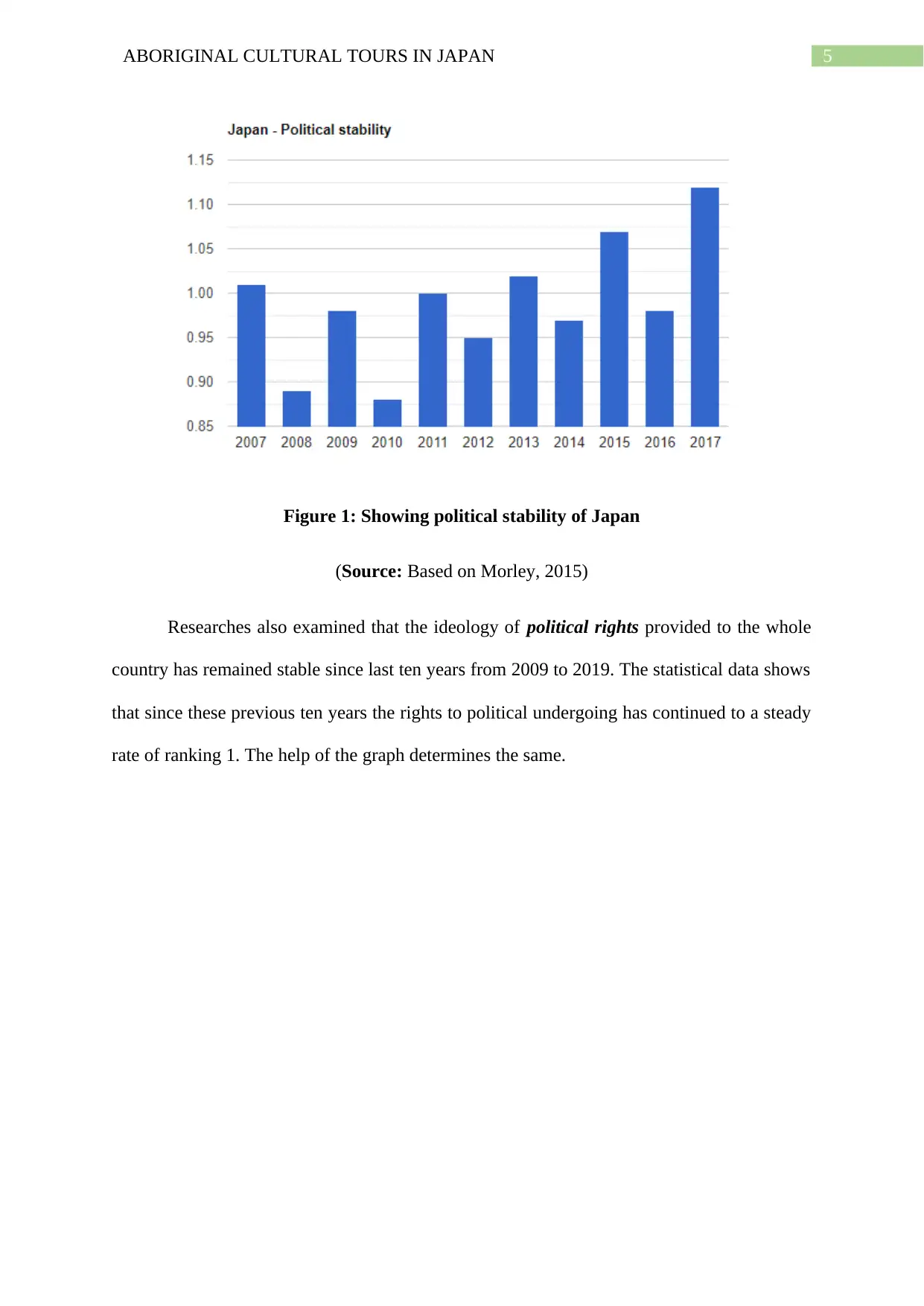
5ABORIGINAL CULTURAL TOURS IN JAPAN
Figure 1: Showing political stability of Japan
(Source: Based on Morley, 2015)
Researches also examined that the ideology of political rights provided to the whole
country has remained stable since last ten years from 2009 to 2019. The statistical data shows
that since these previous ten years the rights to political undergoing has continued to a steady
rate of ranking 1. The help of the graph determines the same.
Figure 1: Showing political stability of Japan
(Source: Based on Morley, 2015)
Researches also examined that the ideology of political rights provided to the whole
country has remained stable since last ten years from 2009 to 2019. The statistical data shows
that since these previous ten years the rights to political undergoing has continued to a steady
rate of ranking 1. The help of the graph determines the same.

6ABORIGINAL CULTURAL TOURS IN JAPAN
Figure 2: Showing Political Rights stability of Japan
(Source: Based on Pekkanen et al., 2018)
As examined by the above pieces of illustrations, the report tends to analyse that
Japan in the current period is a considerable country to expand the business proposition of
aboriginal cultural tours. This is because of the stability of its political system and less
corruption. This states of being a sufficient strength for the South Australian Tourism
Department to promote their business in Japan internationally.
Economic
As opined by Vernon (2017), Japan holds a strong financial base, standing at the
position of the third largest industrial country all over the globe. The GDP of Japan was
examined at a recognisable rate of $5.073 trillion in the fiscal year of 2009, and the annual
growth rate percentage of GDP is considered to be at 0.4%. The per capita GDP scale of
Japan is examined to be at $39,573, and the inflation rate is at the lowest of (-1.3%). This
illustration states that there is an excellent scope of business opportunities in Japan because of
Figure 2: Showing Political Rights stability of Japan
(Source: Based on Pekkanen et al., 2018)
As examined by the above pieces of illustrations, the report tends to analyse that
Japan in the current period is a considerable country to expand the business proposition of
aboriginal cultural tours. This is because of the stability of its political system and less
corruption. This states of being a sufficient strength for the South Australian Tourism
Department to promote their business in Japan internationally.
Economic
As opined by Vernon (2017), Japan holds a strong financial base, standing at the
position of the third largest industrial country all over the globe. The GDP of Japan was
examined at a recognisable rate of $5.073 trillion in the fiscal year of 2009, and the annual
growth rate percentage of GDP is considered to be at 0.4%. The per capita GDP scale of
Japan is examined to be at $39,573, and the inflation rate is at the lowest of (-1.3%). This
illustration states that there is an excellent scope of business opportunities in Japan because of
Paraphrase This Document
Need a fresh take? Get an instant paraphrase of this document with our AI Paraphraser
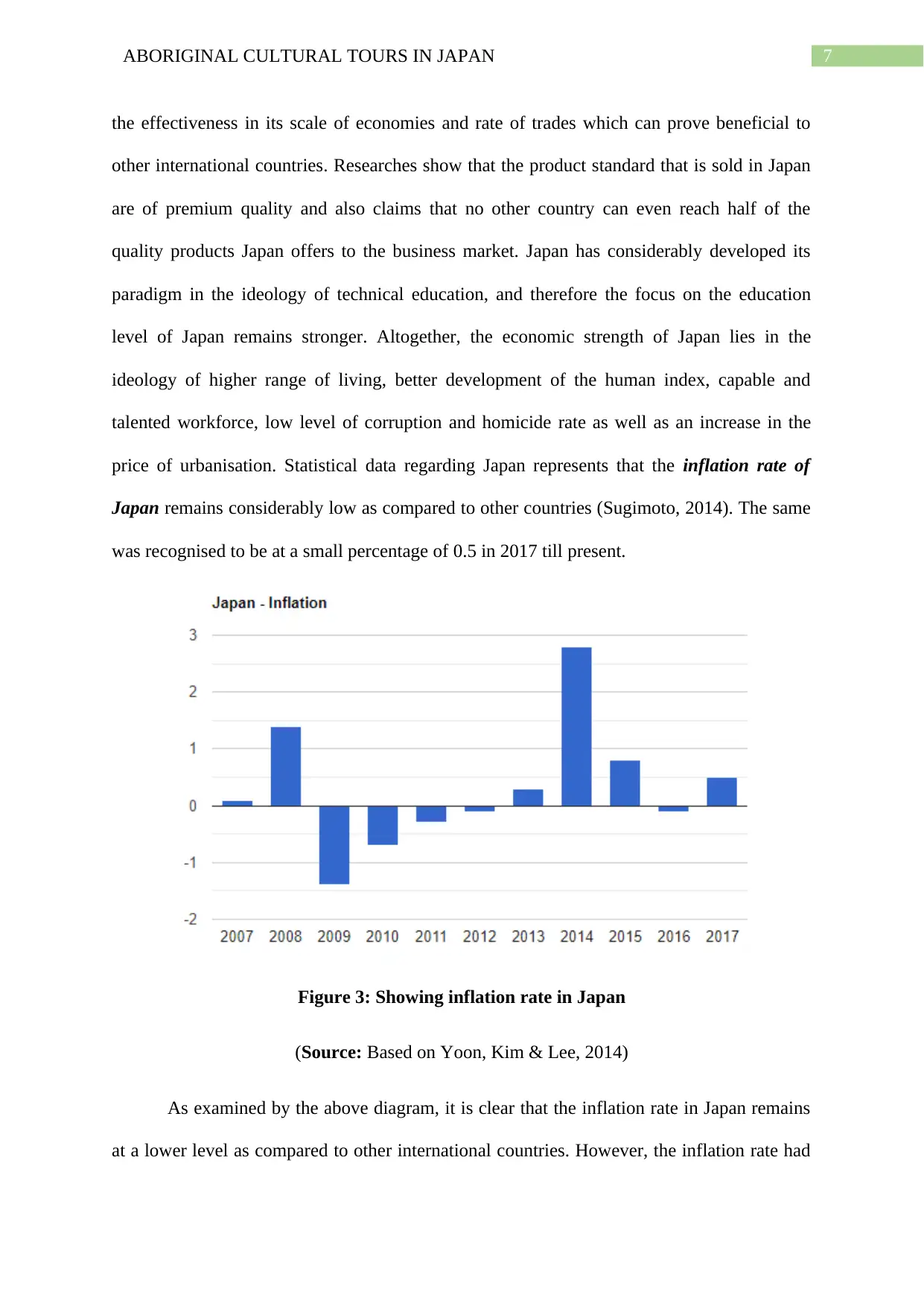
7ABORIGINAL CULTURAL TOURS IN JAPAN
the effectiveness in its scale of economies and rate of trades which can prove beneficial to
other international countries. Researches show that the product standard that is sold in Japan
are of premium quality and also claims that no other country can even reach half of the
quality products Japan offers to the business market. Japan has considerably developed its
paradigm in the ideology of technical education, and therefore the focus on the education
level of Japan remains stronger. Altogether, the economic strength of Japan lies in the
ideology of higher range of living, better development of the human index, capable and
talented workforce, low level of corruption and homicide rate as well as an increase in the
price of urbanisation. Statistical data regarding Japan represents that the inflation rate of
Japan remains considerably low as compared to other countries (Sugimoto, 2014). The same
was recognised to be at a small percentage of 0.5 in 2017 till present.
Figure 3: Showing inflation rate in Japan
(Source: Based on Yoon, Kim & Lee, 2014)
As examined by the above diagram, it is clear that the inflation rate in Japan remains
at a lower level as compared to other international countries. However, the inflation rate had
the effectiveness in its scale of economies and rate of trades which can prove beneficial to
other international countries. Researches show that the product standard that is sold in Japan
are of premium quality and also claims that no other country can even reach half of the
quality products Japan offers to the business market. Japan has considerably developed its
paradigm in the ideology of technical education, and therefore the focus on the education
level of Japan remains stronger. Altogether, the economic strength of Japan lies in the
ideology of higher range of living, better development of the human index, capable and
talented workforce, low level of corruption and homicide rate as well as an increase in the
price of urbanisation. Statistical data regarding Japan represents that the inflation rate of
Japan remains considerably low as compared to other countries (Sugimoto, 2014). The same
was recognised to be at a small percentage of 0.5 in 2017 till present.
Figure 3: Showing inflation rate in Japan
(Source: Based on Yoon, Kim & Lee, 2014)
As examined by the above diagram, it is clear that the inflation rate in Japan remains
at a lower level as compared to other international countries. However, the inflation rate had
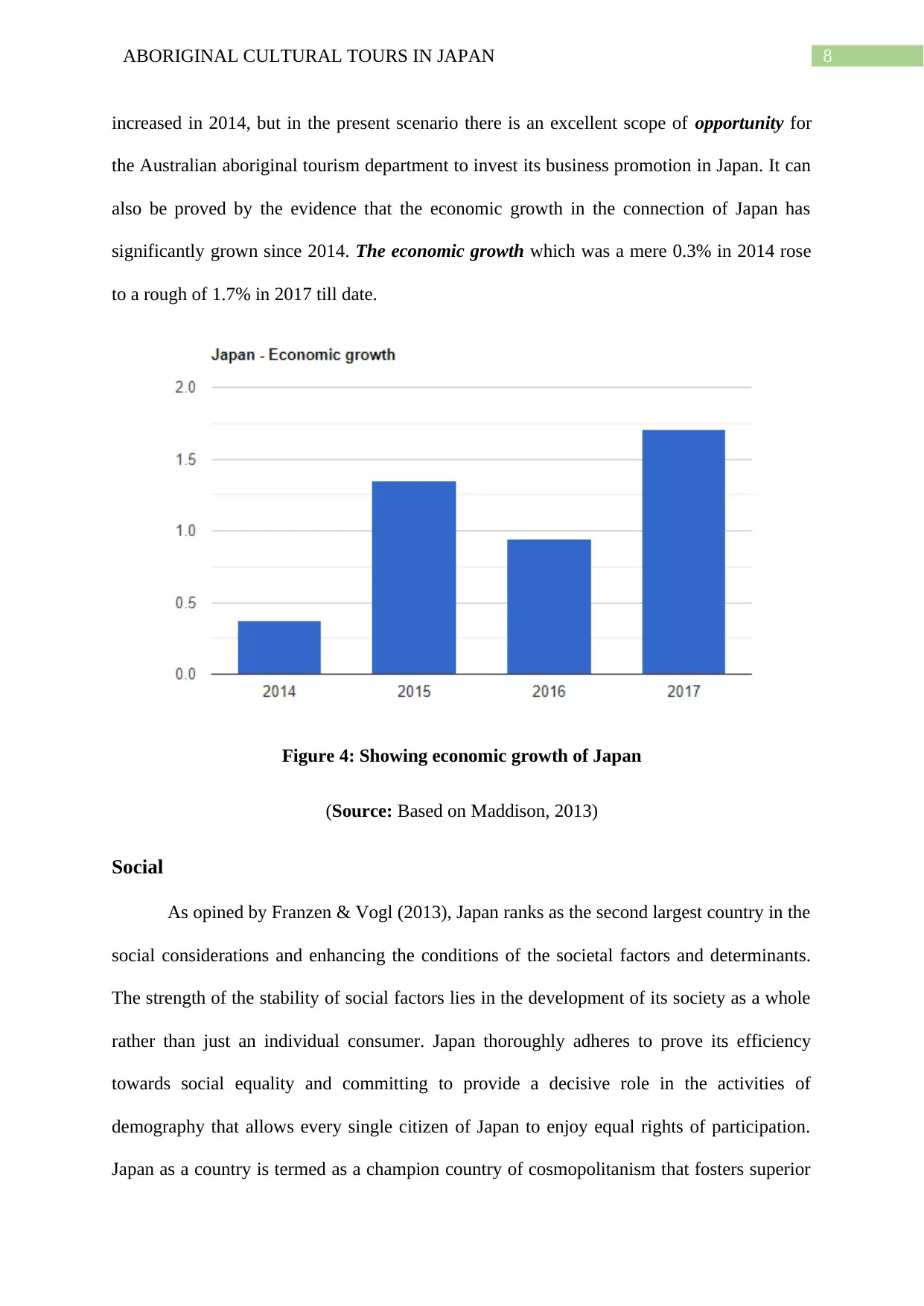
8ABORIGINAL CULTURAL TOURS IN JAPAN
increased in 2014, but in the present scenario there is an excellent scope of opportunity for
the Australian aboriginal tourism department to invest its business promotion in Japan. It can
also be proved by the evidence that the economic growth in the connection of Japan has
significantly grown since 2014. The economic growth which was a mere 0.3% in 2014 rose
to a rough of 1.7% in 2017 till date.
Figure 4: Showing economic growth of Japan
(Source: Based on Maddison, 2013)
Social
As opined by Franzen & Vogl (2013), Japan ranks as the second largest country in the
social considerations and enhancing the conditions of the societal factors and determinants.
The strength of the stability of social factors lies in the development of its society as a whole
rather than just an individual consumer. Japan thoroughly adheres to prove its efficiency
towards social equality and committing to provide a decisive role in the activities of
demography that allows every single citizen of Japan to enjoy equal rights of participation.
Japan as a country is termed as a champion country of cosmopolitanism that fosters superior
increased in 2014, but in the present scenario there is an excellent scope of opportunity for
the Australian aboriginal tourism department to invest its business promotion in Japan. It can
also be proved by the evidence that the economic growth in the connection of Japan has
significantly grown since 2014. The economic growth which was a mere 0.3% in 2014 rose
to a rough of 1.7% in 2017 till date.
Figure 4: Showing economic growth of Japan
(Source: Based on Maddison, 2013)
Social
As opined by Franzen & Vogl (2013), Japan ranks as the second largest country in the
social considerations and enhancing the conditions of the societal factors and determinants.
The strength of the stability of social factors lies in the development of its society as a whole
rather than just an individual consumer. Japan thoroughly adheres to prove its efficiency
towards social equality and committing to provide a decisive role in the activities of
demography that allows every single citizen of Japan to enjoy equal rights of participation.
Japan as a country is termed as a champion country of cosmopolitanism that fosters superior
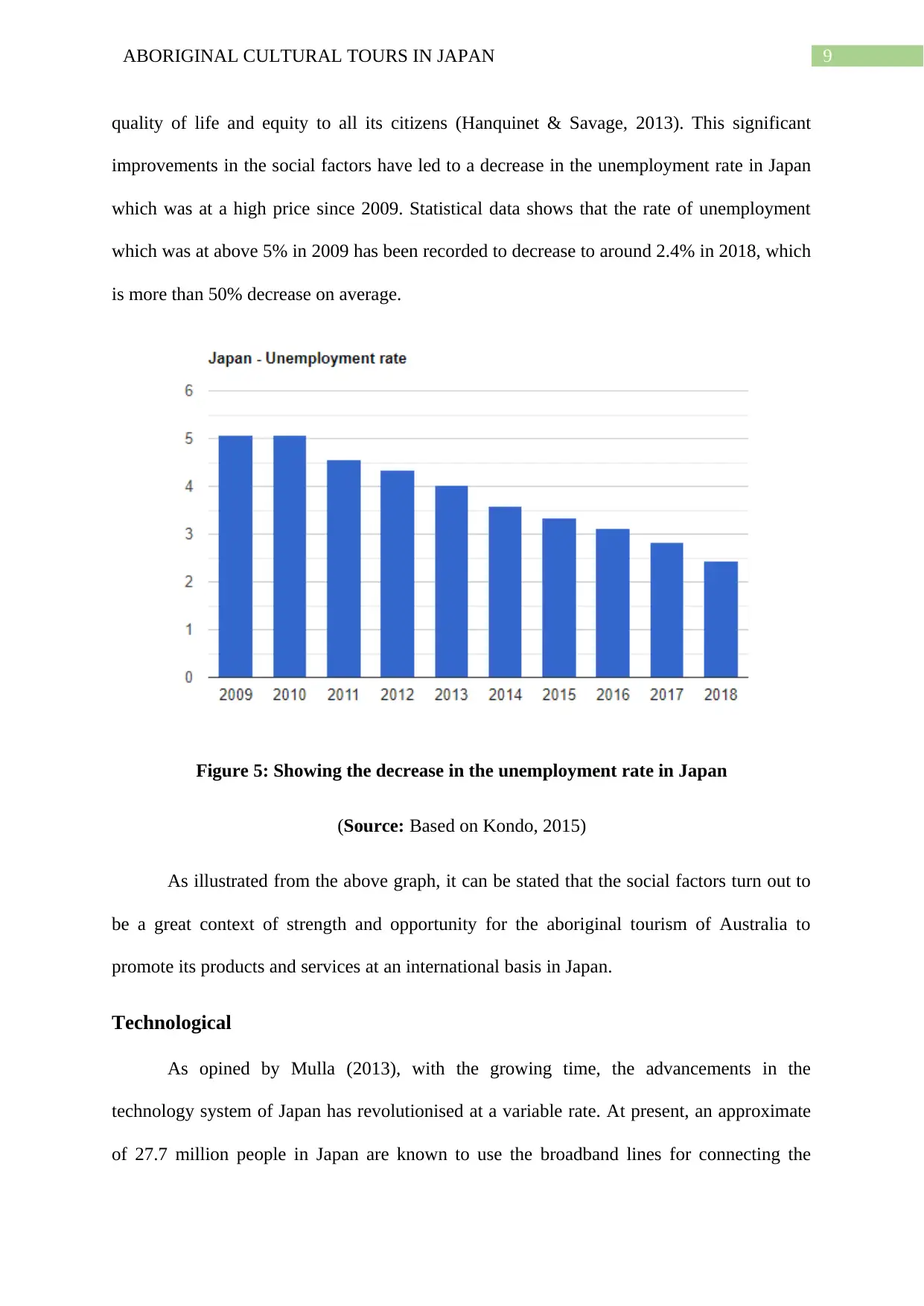
9ABORIGINAL CULTURAL TOURS IN JAPAN
quality of life and equity to all its citizens (Hanquinet & Savage, 2013). This significant
improvements in the social factors have led to a decrease in the unemployment rate in Japan
which was at a high price since 2009. Statistical data shows that the rate of unemployment
which was at above 5% in 2009 has been recorded to decrease to around 2.4% in 2018, which
is more than 50% decrease on average.
Figure 5: Showing the decrease in the unemployment rate in Japan
(Source: Based on Kondo, 2015)
As illustrated from the above graph, it can be stated that the social factors turn out to
be a great context of strength and opportunity for the aboriginal tourism of Australia to
promote its products and services at an international basis in Japan.
Technological
As opined by Mulla (2013), with the growing time, the advancements in the
technology system of Japan has revolutionised at a variable rate. At present, an approximate
of 27.7 million people in Japan are known to use the broadband lines for connecting the
quality of life and equity to all its citizens (Hanquinet & Savage, 2013). This significant
improvements in the social factors have led to a decrease in the unemployment rate in Japan
which was at a high price since 2009. Statistical data shows that the rate of unemployment
which was at above 5% in 2009 has been recorded to decrease to around 2.4% in 2018, which
is more than 50% decrease on average.
Figure 5: Showing the decrease in the unemployment rate in Japan
(Source: Based on Kondo, 2015)
As illustrated from the above graph, it can be stated that the social factors turn out to
be a great context of strength and opportunity for the aboriginal tourism of Australia to
promote its products and services at an international basis in Japan.
Technological
As opined by Mulla (2013), with the growing time, the advancements in the
technology system of Japan has revolutionised at a variable rate. At present, an approximate
of 27.7 million people in Japan are known to use the broadband lines for connecting the
Secure Best Marks with AI Grader
Need help grading? Try our AI Grader for instant feedback on your assignments.
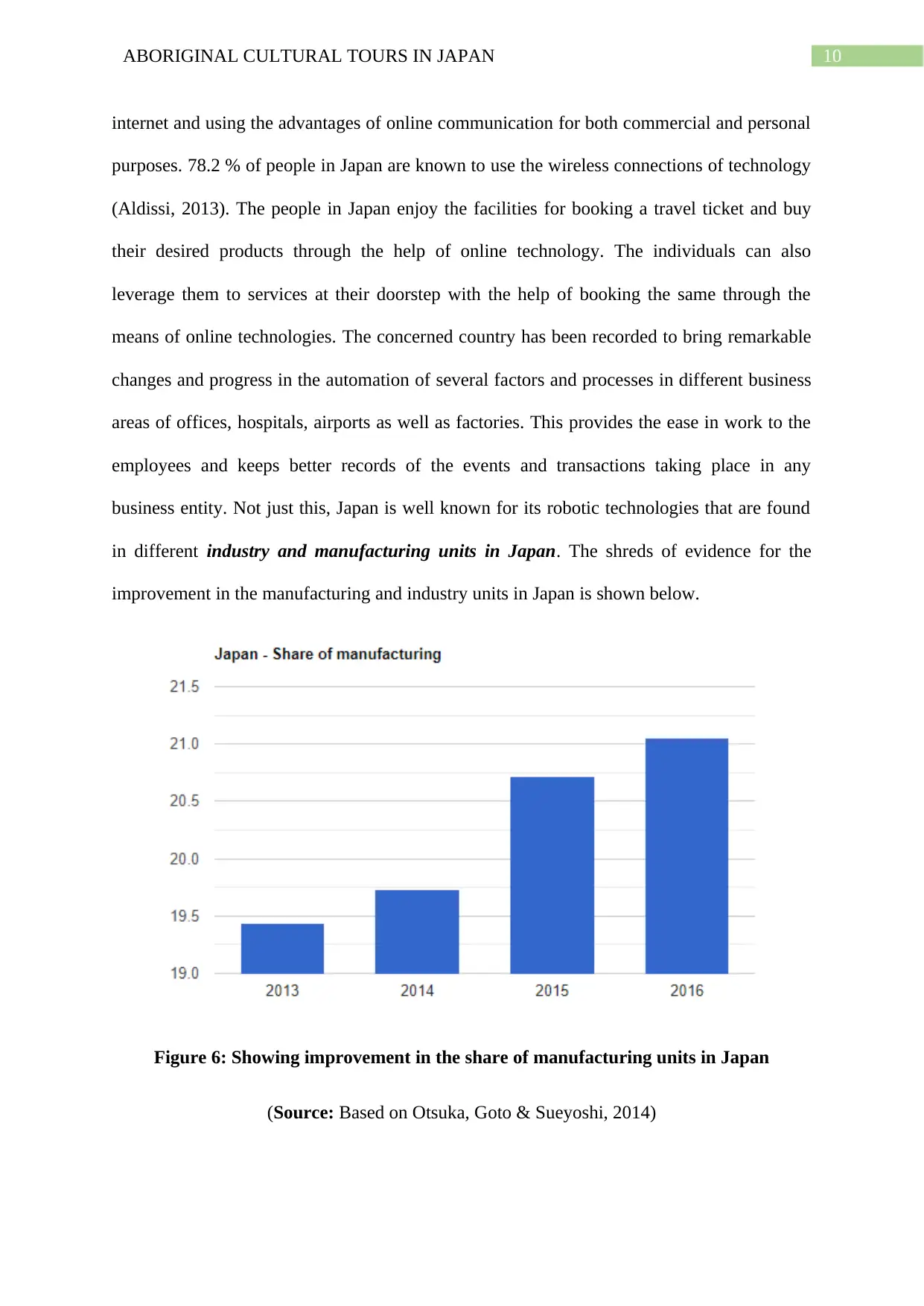
10ABORIGINAL CULTURAL TOURS IN JAPAN
internet and using the advantages of online communication for both commercial and personal
purposes. 78.2 % of people in Japan are known to use the wireless connections of technology
(Aldissi, 2013). The people in Japan enjoy the facilities for booking a travel ticket and buy
their desired products through the help of online technology. The individuals can also
leverage them to services at their doorstep with the help of booking the same through the
means of online technologies. The concerned country has been recorded to bring remarkable
changes and progress in the automation of several factors and processes in different business
areas of offices, hospitals, airports as well as factories. This provides the ease in work to the
employees and keeps better records of the events and transactions taking place in any
business entity. Not just this, Japan is well known for its robotic technologies that are found
in different industry and manufacturing units in Japan. The shreds of evidence for the
improvement in the manufacturing and industry units in Japan is shown below.
Figure 6: Showing improvement in the share of manufacturing units in Japan
(Source: Based on Otsuka, Goto & Sueyoshi, 2014)
internet and using the advantages of online communication for both commercial and personal
purposes. 78.2 % of people in Japan are known to use the wireless connections of technology
(Aldissi, 2013). The people in Japan enjoy the facilities for booking a travel ticket and buy
their desired products through the help of online technology. The individuals can also
leverage them to services at their doorstep with the help of booking the same through the
means of online technologies. The concerned country has been recorded to bring remarkable
changes and progress in the automation of several factors and processes in different business
areas of offices, hospitals, airports as well as factories. This provides the ease in work to the
employees and keeps better records of the events and transactions taking place in any
business entity. Not just this, Japan is well known for its robotic technologies that are found
in different industry and manufacturing units in Japan. The shreds of evidence for the
improvement in the manufacturing and industry units in Japan is shown below.
Figure 6: Showing improvement in the share of manufacturing units in Japan
(Source: Based on Otsuka, Goto & Sueyoshi, 2014)
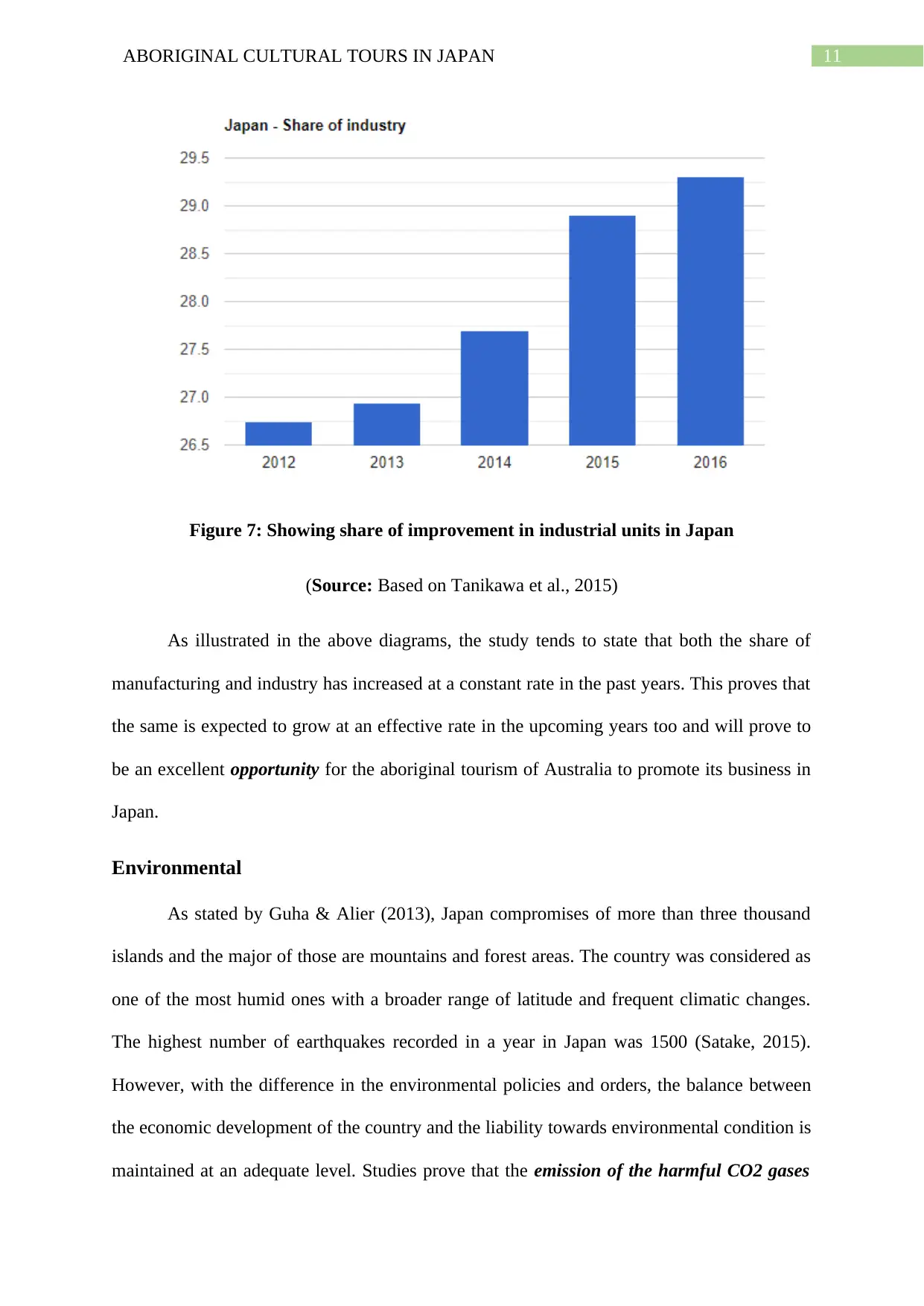
11ABORIGINAL CULTURAL TOURS IN JAPAN
Figure 7: Showing share of improvement in industrial units in Japan
(Source: Based on Tanikawa et al., 2015)
As illustrated in the above diagrams, the study tends to state that both the share of
manufacturing and industry has increased at a constant rate in the past years. This proves that
the same is expected to grow at an effective rate in the upcoming years too and will prove to
be an excellent opportunity for the aboriginal tourism of Australia to promote its business in
Japan.
Environmental
As stated by Guha & Alier (2013), Japan compromises of more than three thousand
islands and the major of those are mountains and forest areas. The country was considered as
one of the most humid ones with a broader range of latitude and frequent climatic changes.
The highest number of earthquakes recorded in a year in Japan was 1500 (Satake, 2015).
However, with the difference in the environmental policies and orders, the balance between
the economic development of the country and the liability towards environmental condition is
maintained at an adequate level. Studies prove that the emission of the harmful CO2 gases
Figure 7: Showing share of improvement in industrial units in Japan
(Source: Based on Tanikawa et al., 2015)
As illustrated in the above diagrams, the study tends to state that both the share of
manufacturing and industry has increased at a constant rate in the past years. This proves that
the same is expected to grow at an effective rate in the upcoming years too and will prove to
be an excellent opportunity for the aboriginal tourism of Australia to promote its business in
Japan.
Environmental
As stated by Guha & Alier (2013), Japan compromises of more than three thousand
islands and the major of those are mountains and forest areas. The country was considered as
one of the most humid ones with a broader range of latitude and frequent climatic changes.
The highest number of earthquakes recorded in a year in Japan was 1500 (Satake, 2015).
However, with the difference in the environmental policies and orders, the balance between
the economic development of the country and the liability towards environmental condition is
maintained at an adequate level. Studies prove that the emission of the harmful CO2 gases
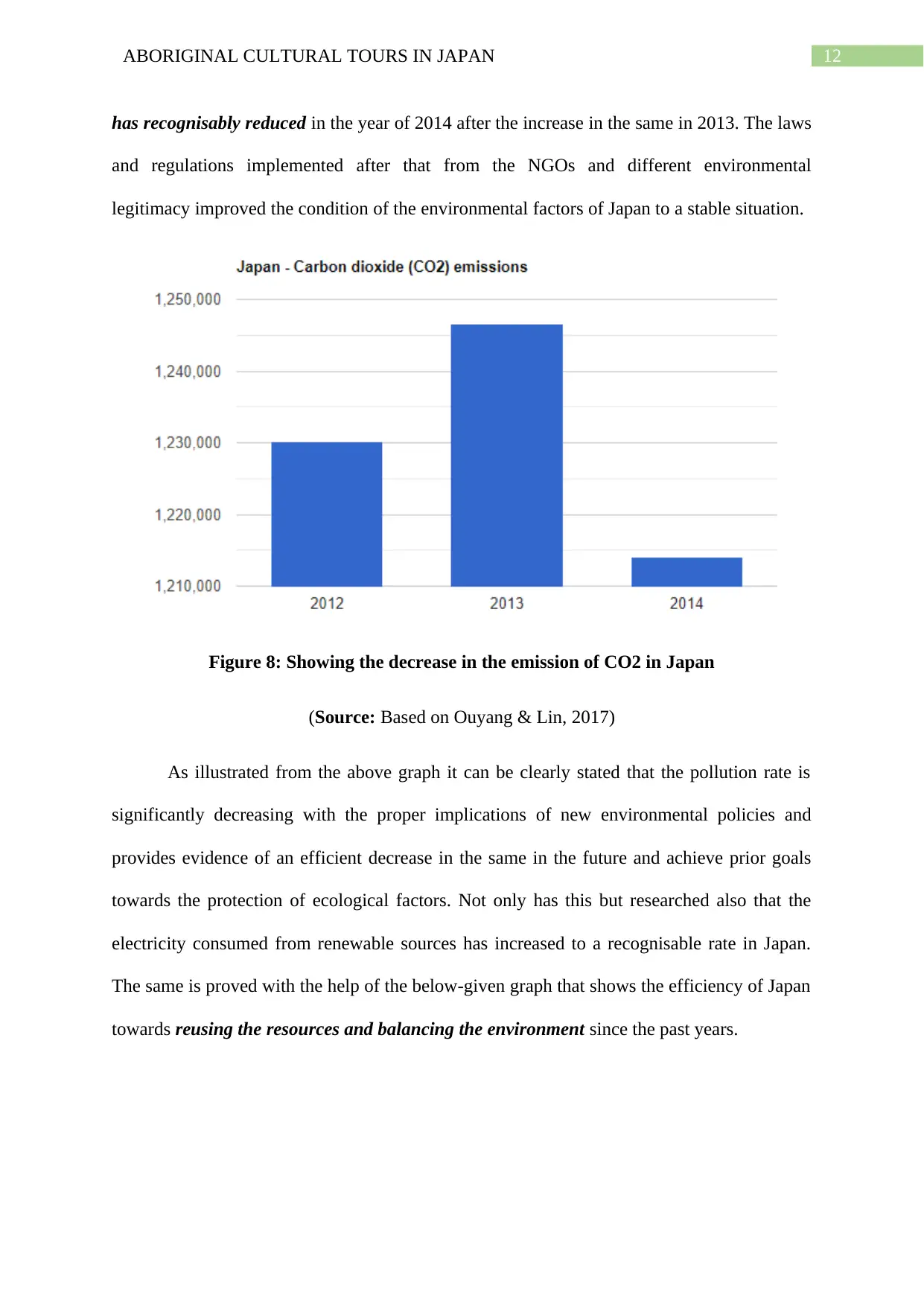
12ABORIGINAL CULTURAL TOURS IN JAPAN
has recognisably reduced in the year of 2014 after the increase in the same in 2013. The laws
and regulations implemented after that from the NGOs and different environmental
legitimacy improved the condition of the environmental factors of Japan to a stable situation.
Figure 8: Showing the decrease in the emission of CO2 in Japan
(Source: Based on Ouyang & Lin, 2017)
As illustrated from the above graph it can be clearly stated that the pollution rate is
significantly decreasing with the proper implications of new environmental policies and
provides evidence of an efficient decrease in the same in the future and achieve prior goals
towards the protection of ecological factors. Not only has this but researched also that the
electricity consumed from renewable sources has increased to a recognisable rate in Japan.
The same is proved with the help of the below-given graph that shows the efficiency of Japan
towards reusing the resources and balancing the environment since the past years.
has recognisably reduced in the year of 2014 after the increase in the same in 2013. The laws
and regulations implemented after that from the NGOs and different environmental
legitimacy improved the condition of the environmental factors of Japan to a stable situation.
Figure 8: Showing the decrease in the emission of CO2 in Japan
(Source: Based on Ouyang & Lin, 2017)
As illustrated from the above graph it can be clearly stated that the pollution rate is
significantly decreasing with the proper implications of new environmental policies and
provides evidence of an efficient decrease in the same in the future and achieve prior goals
towards the protection of ecological factors. Not only has this but researched also that the
electricity consumed from renewable sources has increased to a recognisable rate in Japan.
The same is proved with the help of the below-given graph that shows the efficiency of Japan
towards reusing the resources and balancing the environment since the past years.
Paraphrase This Document
Need a fresh take? Get an instant paraphrase of this document with our AI Paraphraser
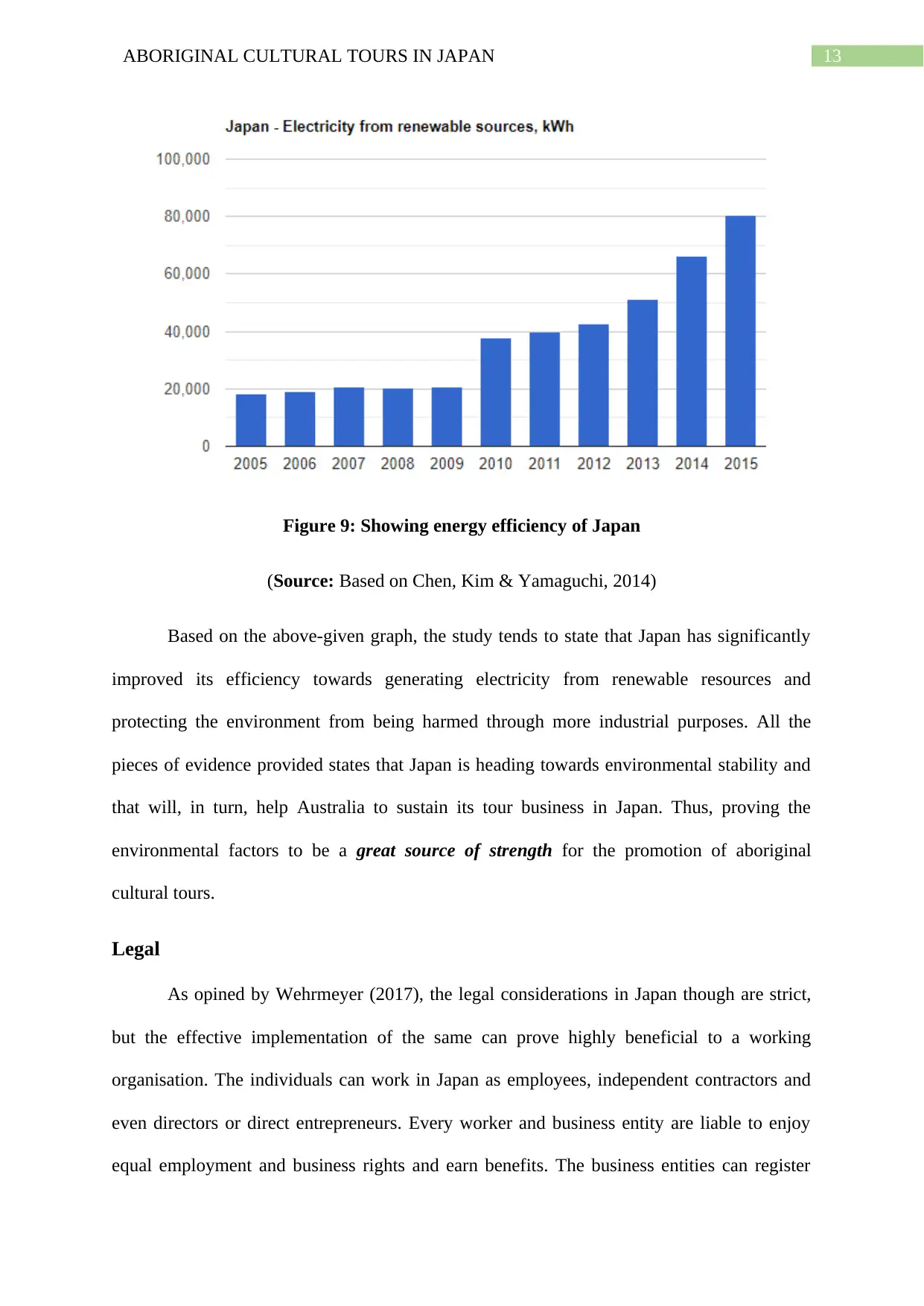
13ABORIGINAL CULTURAL TOURS IN JAPAN
Figure 9: Showing energy efficiency of Japan
(Source: Based on Chen, Kim & Yamaguchi, 2014)
Based on the above-given graph, the study tends to state that Japan has significantly
improved its efficiency towards generating electricity from renewable resources and
protecting the environment from being harmed through more industrial purposes. All the
pieces of evidence provided states that Japan is heading towards environmental stability and
that will, in turn, help Australia to sustain its tour business in Japan. Thus, proving the
environmental factors to be a great source of strength for the promotion of aboriginal
cultural tours.
Legal
As opined by Wehrmeyer (2017), the legal considerations in Japan though are strict,
but the effective implementation of the same can prove highly beneficial to a working
organisation. The individuals can work in Japan as employees, independent contractors and
even directors or direct entrepreneurs. Every worker and business entity are liable to enjoy
equal employment and business rights and earn benefits. The business entities can register
Figure 9: Showing energy efficiency of Japan
(Source: Based on Chen, Kim & Yamaguchi, 2014)
Based on the above-given graph, the study tends to state that Japan has significantly
improved its efficiency towards generating electricity from renewable resources and
protecting the environment from being harmed through more industrial purposes. All the
pieces of evidence provided states that Japan is heading towards environmental stability and
that will, in turn, help Australia to sustain its tour business in Japan. Thus, proving the
environmental factors to be a great source of strength for the promotion of aboriginal
cultural tours.
Legal
As opined by Wehrmeyer (2017), the legal considerations in Japan though are strict,
but the effective implementation of the same can prove highly beneficial to a working
organisation. The individuals can work in Japan as employees, independent contractors and
even directors or direct entrepreneurs. Every worker and business entity are liable to enjoy
equal employment and business rights and earn benefits. The business entities can register
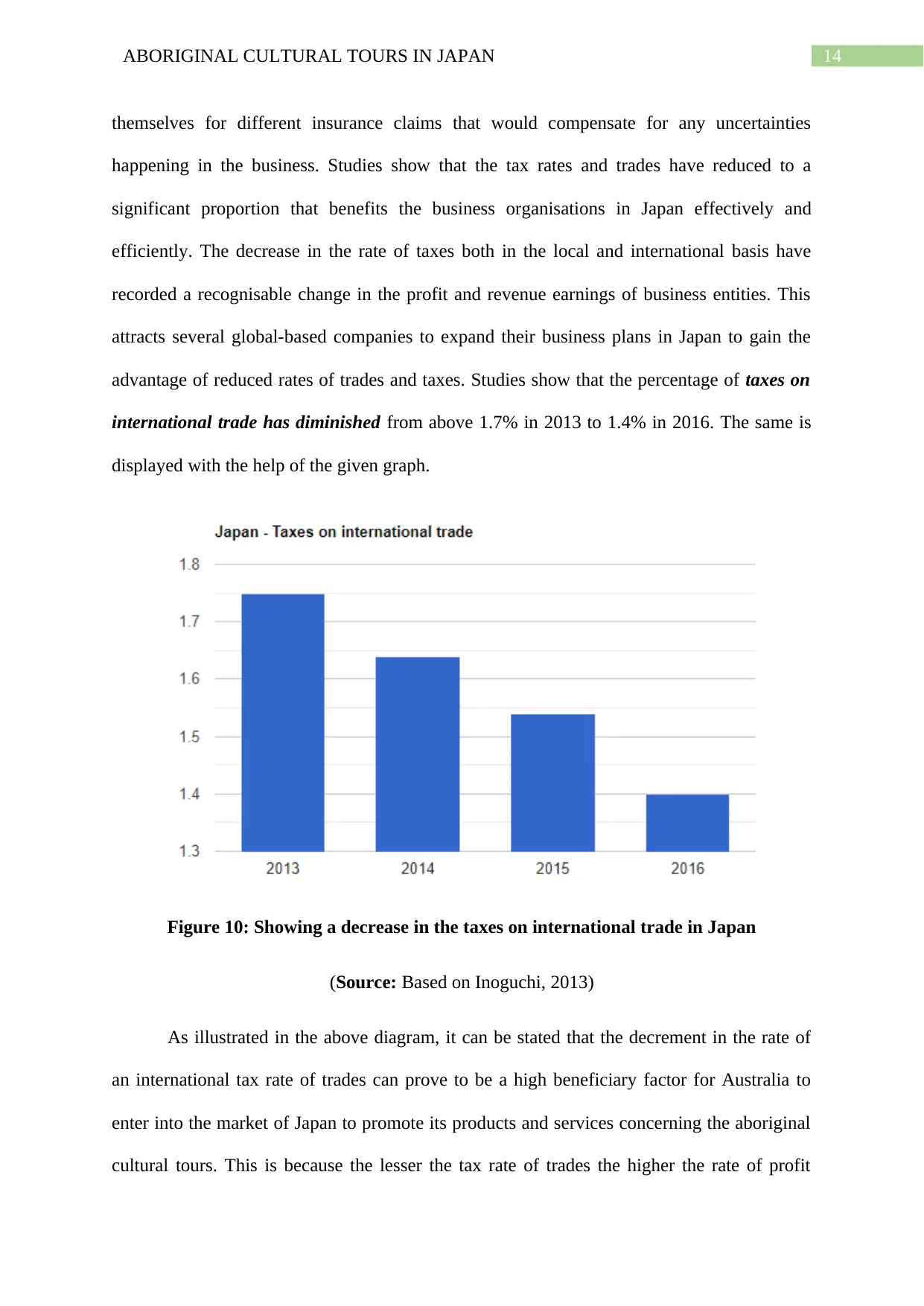
14ABORIGINAL CULTURAL TOURS IN JAPAN
themselves for different insurance claims that would compensate for any uncertainties
happening in the business. Studies show that the tax rates and trades have reduced to a
significant proportion that benefits the business organisations in Japan effectively and
efficiently. The decrease in the rate of taxes both in the local and international basis have
recorded a recognisable change in the profit and revenue earnings of business entities. This
attracts several global-based companies to expand their business plans in Japan to gain the
advantage of reduced rates of trades and taxes. Studies show that the percentage of taxes on
international trade has diminished from above 1.7% in 2013 to 1.4% in 2016. The same is
displayed with the help of the given graph.
Figure 10: Showing a decrease in the taxes on international trade in Japan
(Source: Based on Inoguchi, 2013)
As illustrated in the above diagram, it can be stated that the decrement in the rate of
an international tax rate of trades can prove to be a high beneficiary factor for Australia to
enter into the market of Japan to promote its products and services concerning the aboriginal
cultural tours. This is because the lesser the tax rate of trades the higher the rate of profit
themselves for different insurance claims that would compensate for any uncertainties
happening in the business. Studies show that the tax rates and trades have reduced to a
significant proportion that benefits the business organisations in Japan effectively and
efficiently. The decrease in the rate of taxes both in the local and international basis have
recorded a recognisable change in the profit and revenue earnings of business entities. This
attracts several global-based companies to expand their business plans in Japan to gain the
advantage of reduced rates of trades and taxes. Studies show that the percentage of taxes on
international trade has diminished from above 1.7% in 2013 to 1.4% in 2016. The same is
displayed with the help of the given graph.
Figure 10: Showing a decrease in the taxes on international trade in Japan
(Source: Based on Inoguchi, 2013)
As illustrated in the above diagram, it can be stated that the decrement in the rate of
an international tax rate of trades can prove to be a high beneficiary factor for Australia to
enter into the market of Japan to promote its products and services concerning the aboriginal
cultural tours. This is because the lesser the tax rate of trades the higher the rate of profit
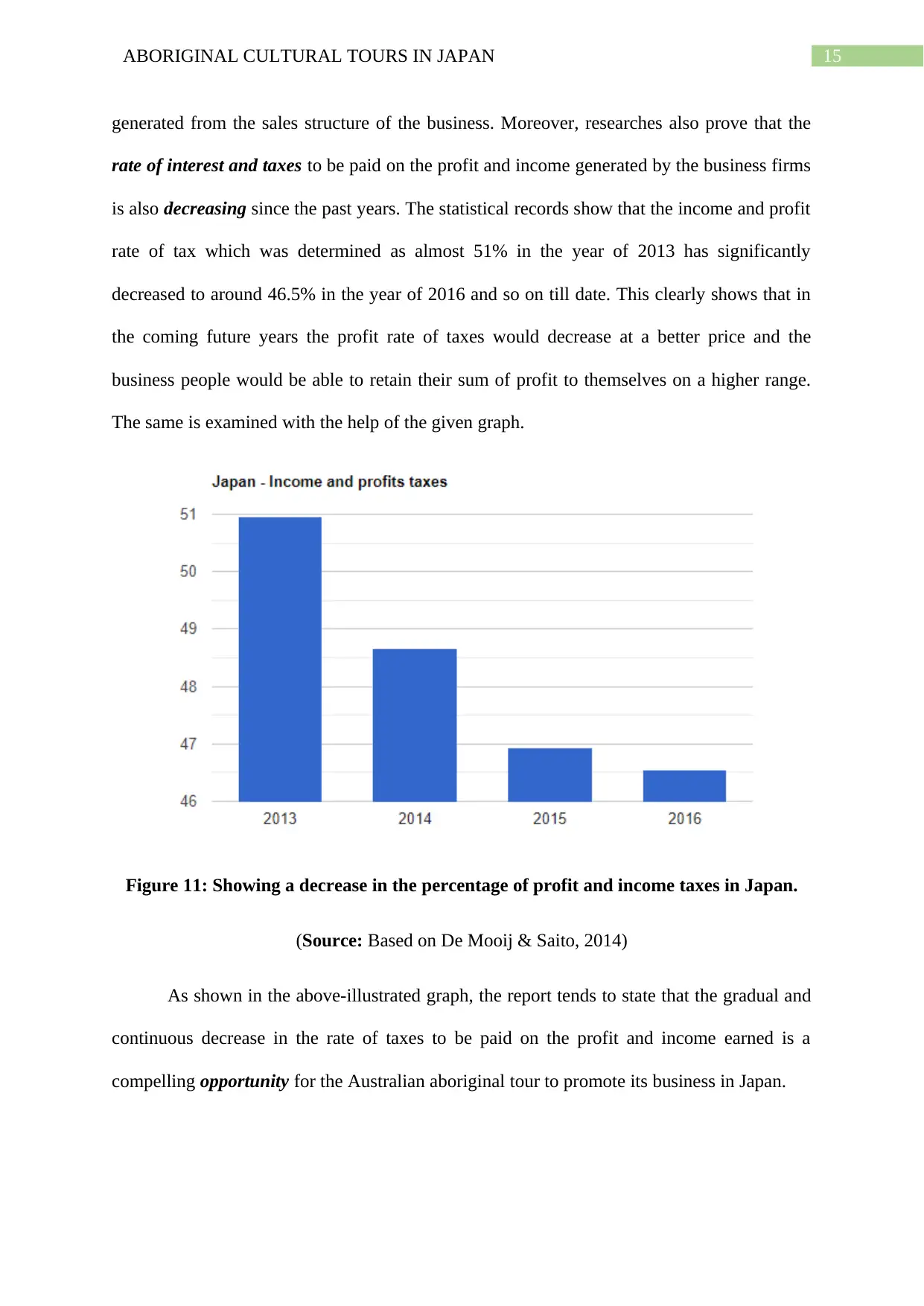
15ABORIGINAL CULTURAL TOURS IN JAPAN
generated from the sales structure of the business. Moreover, researches also prove that the
rate of interest and taxes to be paid on the profit and income generated by the business firms
is also decreasing since the past years. The statistical records show that the income and profit
rate of tax which was determined as almost 51% in the year of 2013 has significantly
decreased to around 46.5% in the year of 2016 and so on till date. This clearly shows that in
the coming future years the profit rate of taxes would decrease at a better price and the
business people would be able to retain their sum of profit to themselves on a higher range.
The same is examined with the help of the given graph.
Figure 11: Showing a decrease in the percentage of profit and income taxes in Japan.
(Source: Based on De Mooij & Saito, 2014)
As shown in the above-illustrated graph, the report tends to state that the gradual and
continuous decrease in the rate of taxes to be paid on the profit and income earned is a
compelling opportunity for the Australian aboriginal tour to promote its business in Japan.
generated from the sales structure of the business. Moreover, researches also prove that the
rate of interest and taxes to be paid on the profit and income generated by the business firms
is also decreasing since the past years. The statistical records show that the income and profit
rate of tax which was determined as almost 51% in the year of 2013 has significantly
decreased to around 46.5% in the year of 2016 and so on till date. This clearly shows that in
the coming future years the profit rate of taxes would decrease at a better price and the
business people would be able to retain their sum of profit to themselves on a higher range.
The same is examined with the help of the given graph.
Figure 11: Showing a decrease in the percentage of profit and income taxes in Japan.
(Source: Based on De Mooij & Saito, 2014)
As shown in the above-illustrated graph, the report tends to state that the gradual and
continuous decrease in the rate of taxes to be paid on the profit and income earned is a
compelling opportunity for the Australian aboriginal tour to promote its business in Japan.
Secure Best Marks with AI Grader
Need help grading? Try our AI Grader for instant feedback on your assignments.
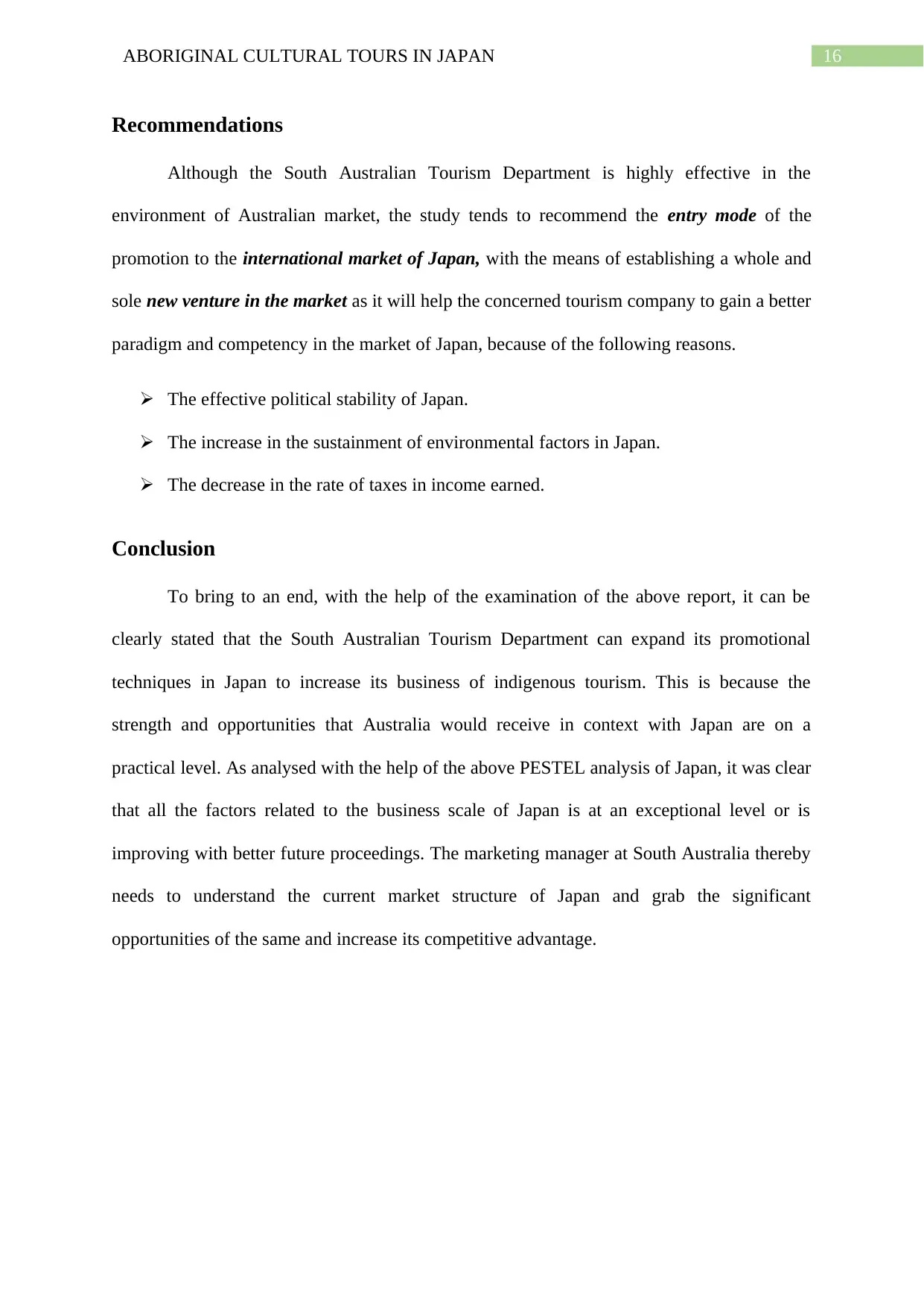
16ABORIGINAL CULTURAL TOURS IN JAPAN
Recommendations
Although the South Australian Tourism Department is highly effective in the
environment of Australian market, the study tends to recommend the entry mode of the
promotion to the international market of Japan, with the means of establishing a whole and
sole new venture in the market as it will help the concerned tourism company to gain a better
paradigm and competency in the market of Japan, because of the following reasons.
The effective political stability of Japan.
The increase in the sustainment of environmental factors in Japan.
The decrease in the rate of taxes in income earned.
Conclusion
To bring to an end, with the help of the examination of the above report, it can be
clearly stated that the South Australian Tourism Department can expand its promotional
techniques in Japan to increase its business of indigenous tourism. This is because the
strength and opportunities that Australia would receive in context with Japan are on a
practical level. As analysed with the help of the above PESTEL analysis of Japan, it was clear
that all the factors related to the business scale of Japan is at an exceptional level or is
improving with better future proceedings. The marketing manager at South Australia thereby
needs to understand the current market structure of Japan and grab the significant
opportunities of the same and increase its competitive advantage.
Recommendations
Although the South Australian Tourism Department is highly effective in the
environment of Australian market, the study tends to recommend the entry mode of the
promotion to the international market of Japan, with the means of establishing a whole and
sole new venture in the market as it will help the concerned tourism company to gain a better
paradigm and competency in the market of Japan, because of the following reasons.
The effective political stability of Japan.
The increase in the sustainment of environmental factors in Japan.
The decrease in the rate of taxes in income earned.
Conclusion
To bring to an end, with the help of the examination of the above report, it can be
clearly stated that the South Australian Tourism Department can expand its promotional
techniques in Japan to increase its business of indigenous tourism. This is because the
strength and opportunities that Australia would receive in context with Japan are on a
practical level. As analysed with the help of the above PESTEL analysis of Japan, it was clear
that all the factors related to the business scale of Japan is at an exceptional level or is
improving with better future proceedings. The marketing manager at South Australia thereby
needs to understand the current market structure of Japan and grab the significant
opportunities of the same and increase its competitive advantage.
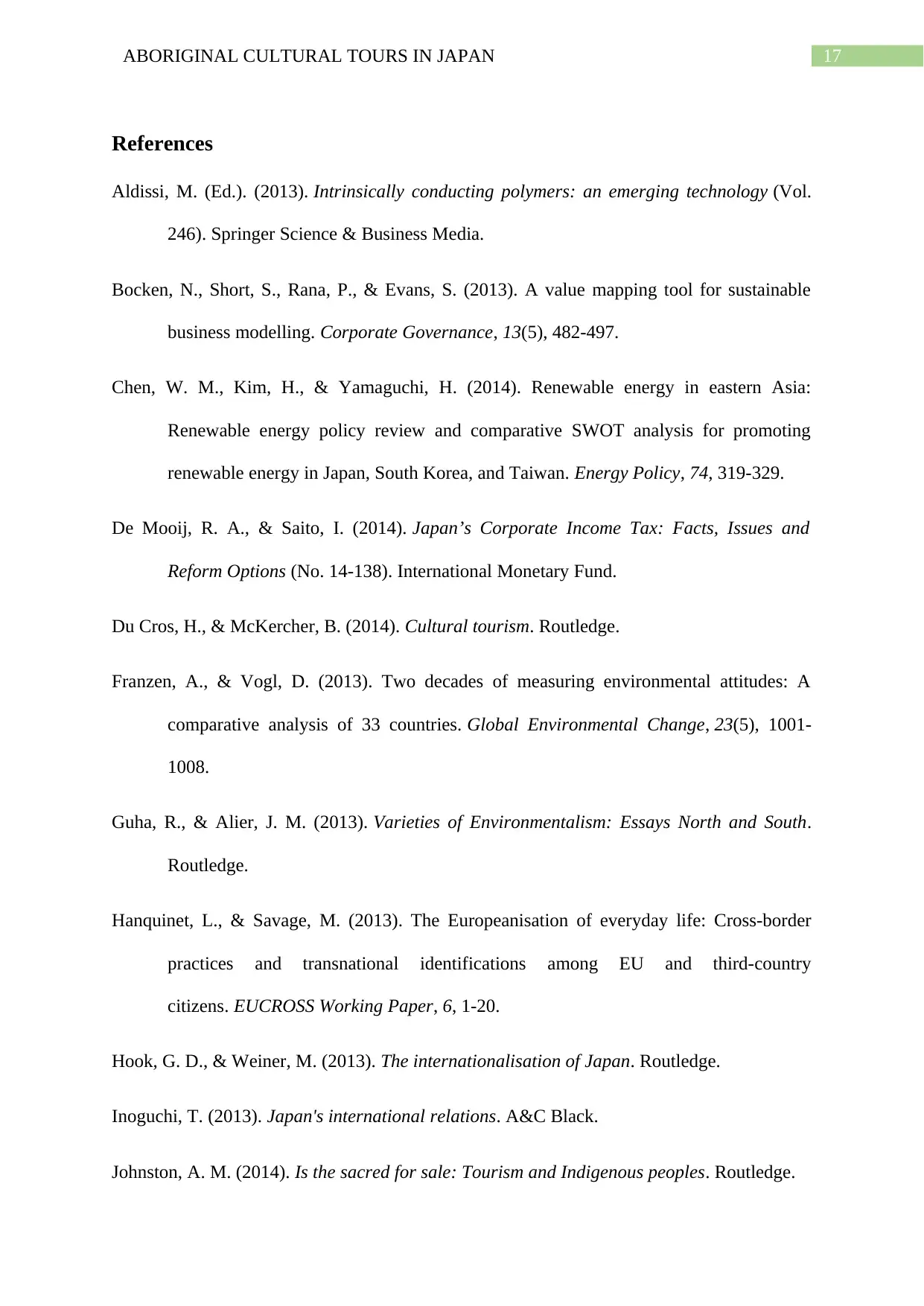
17ABORIGINAL CULTURAL TOURS IN JAPAN
References
Aldissi, M. (Ed.). (2013). Intrinsically conducting polymers: an emerging technology (Vol.
246). Springer Science & Business Media.
Bocken, N., Short, S., Rana, P., & Evans, S. (2013). A value mapping tool for sustainable
business modelling. Corporate Governance, 13(5), 482-497.
Chen, W. M., Kim, H., & Yamaguchi, H. (2014). Renewable energy in eastern Asia:
Renewable energy policy review and comparative SWOT analysis for promoting
renewable energy in Japan, South Korea, and Taiwan. Energy Policy, 74, 319-329.
De Mooij, R. A., & Saito, I. (2014). Japan’s Corporate Income Tax: Facts, Issues and
Reform Options (No. 14-138). International Monetary Fund.
Du Cros, H., & McKercher, B. (2014). Cultural tourism. Routledge.
Franzen, A., & Vogl, D. (2013). Two decades of measuring environmental attitudes: A
comparative analysis of 33 countries. Global Environmental Change, 23(5), 1001-
1008.
Guha, R., & Alier, J. M. (2013). Varieties of Environmentalism: Essays North and South.
Routledge.
Hanquinet, L., & Savage, M. (2013). The Europeanisation of everyday life: Cross-border
practices and transnational identifications among EU and third-country
citizens. EUCROSS Working Paper, 6, 1-20.
Hook, G. D., & Weiner, M. (2013). The internationalisation of Japan. Routledge.
Inoguchi, T. (2013). Japan's international relations. A&C Black.
Johnston, A. M. (2014). Is the sacred for sale: Tourism and Indigenous peoples. Routledge.
References
Aldissi, M. (Ed.). (2013). Intrinsically conducting polymers: an emerging technology (Vol.
246). Springer Science & Business Media.
Bocken, N., Short, S., Rana, P., & Evans, S. (2013). A value mapping tool for sustainable
business modelling. Corporate Governance, 13(5), 482-497.
Chen, W. M., Kim, H., & Yamaguchi, H. (2014). Renewable energy in eastern Asia:
Renewable energy policy review and comparative SWOT analysis for promoting
renewable energy in Japan, South Korea, and Taiwan. Energy Policy, 74, 319-329.
De Mooij, R. A., & Saito, I. (2014). Japan’s Corporate Income Tax: Facts, Issues and
Reform Options (No. 14-138). International Monetary Fund.
Du Cros, H., & McKercher, B. (2014). Cultural tourism. Routledge.
Franzen, A., & Vogl, D. (2013). Two decades of measuring environmental attitudes: A
comparative analysis of 33 countries. Global Environmental Change, 23(5), 1001-
1008.
Guha, R., & Alier, J. M. (2013). Varieties of Environmentalism: Essays North and South.
Routledge.
Hanquinet, L., & Savage, M. (2013). The Europeanisation of everyday life: Cross-border
practices and transnational identifications among EU and third-country
citizens. EUCROSS Working Paper, 6, 1-20.
Hook, G. D., & Weiner, M. (2013). The internationalisation of Japan. Routledge.
Inoguchi, T. (2013). Japan's international relations. A&C Black.
Johnston, A. M. (2014). Is the sacred for sale: Tourism and Indigenous peoples. Routledge.
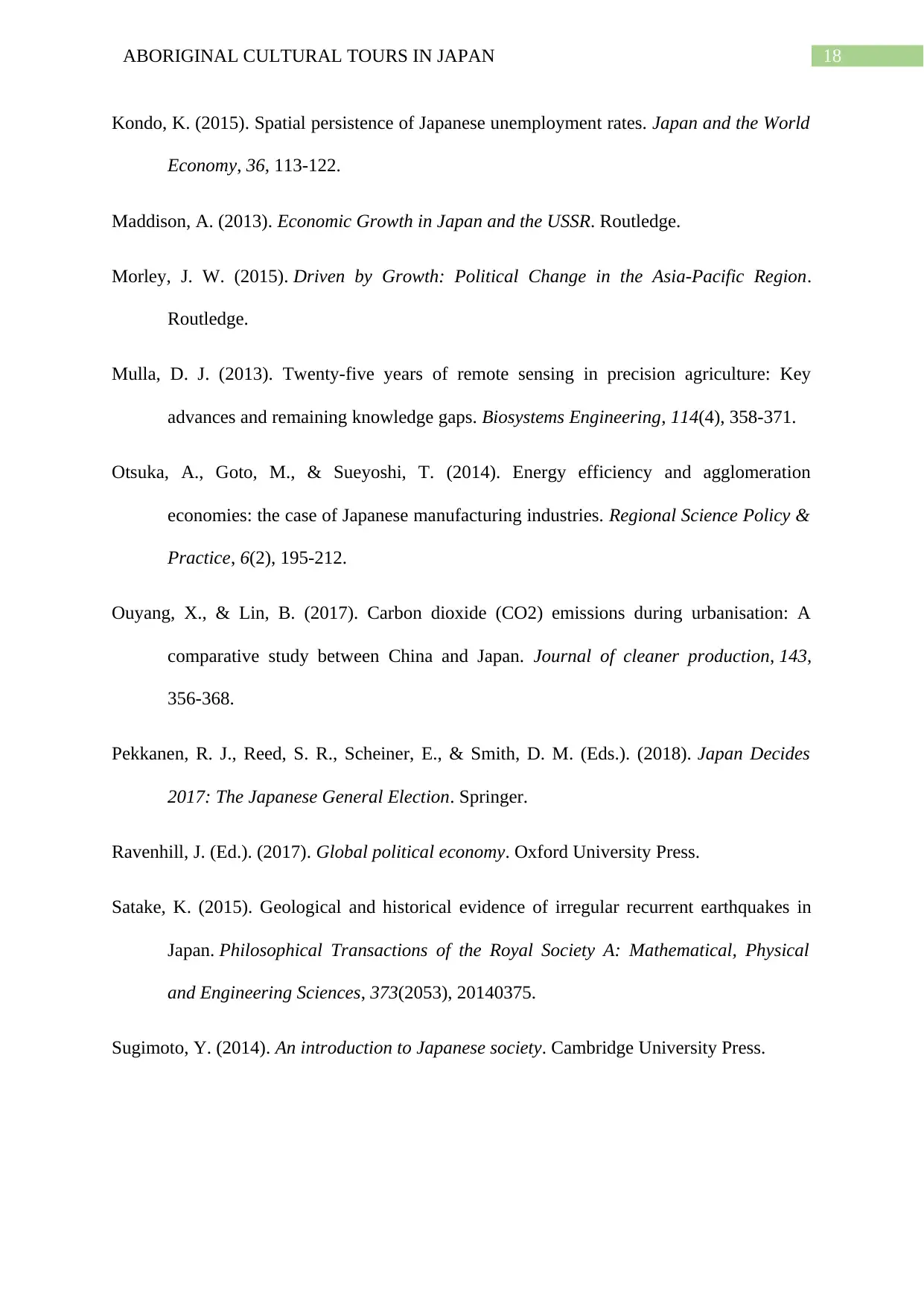
18ABORIGINAL CULTURAL TOURS IN JAPAN
Kondo, K. (2015). Spatial persistence of Japanese unemployment rates. Japan and the World
Economy, 36, 113-122.
Maddison, A. (2013). Economic Growth in Japan and the USSR. Routledge.
Morley, J. W. (2015). Driven by Growth: Political Change in the Asia-Pacific Region.
Routledge.
Mulla, D. J. (2013). Twenty-five years of remote sensing in precision agriculture: Key
advances and remaining knowledge gaps. Biosystems Engineering, 114(4), 358-371.
Otsuka, A., Goto, M., & Sueyoshi, T. (2014). Energy efficiency and agglomeration
economies: the case of Japanese manufacturing industries. Regional Science Policy &
Practice, 6(2), 195-212.
Ouyang, X., & Lin, B. (2017). Carbon dioxide (CO2) emissions during urbanisation: A
comparative study between China and Japan. Journal of cleaner production, 143,
356-368.
Pekkanen, R. J., Reed, S. R., Scheiner, E., & Smith, D. M. (Eds.). (2018). Japan Decides
2017: The Japanese General Election. Springer.
Ravenhill, J. (Ed.). (2017). Global political economy. Oxford University Press.
Satake, K. (2015). Geological and historical evidence of irregular recurrent earthquakes in
Japan. Philosophical Transactions of the Royal Society A: Mathematical, Physical
and Engineering Sciences, 373(2053), 20140375.
Sugimoto, Y. (2014). An introduction to Japanese society. Cambridge University Press.
Kondo, K. (2015). Spatial persistence of Japanese unemployment rates. Japan and the World
Economy, 36, 113-122.
Maddison, A. (2013). Economic Growth in Japan and the USSR. Routledge.
Morley, J. W. (2015). Driven by Growth: Political Change in the Asia-Pacific Region.
Routledge.
Mulla, D. J. (2013). Twenty-five years of remote sensing in precision agriculture: Key
advances and remaining knowledge gaps. Biosystems Engineering, 114(4), 358-371.
Otsuka, A., Goto, M., & Sueyoshi, T. (2014). Energy efficiency and agglomeration
economies: the case of Japanese manufacturing industries. Regional Science Policy &
Practice, 6(2), 195-212.
Ouyang, X., & Lin, B. (2017). Carbon dioxide (CO2) emissions during urbanisation: A
comparative study between China and Japan. Journal of cleaner production, 143,
356-368.
Pekkanen, R. J., Reed, S. R., Scheiner, E., & Smith, D. M. (Eds.). (2018). Japan Decides
2017: The Japanese General Election. Springer.
Ravenhill, J. (Ed.). (2017). Global political economy. Oxford University Press.
Satake, K. (2015). Geological and historical evidence of irregular recurrent earthquakes in
Japan. Philosophical Transactions of the Royal Society A: Mathematical, Physical
and Engineering Sciences, 373(2053), 20140375.
Sugimoto, Y. (2014). An introduction to Japanese society. Cambridge University Press.
Paraphrase This Document
Need a fresh take? Get an instant paraphrase of this document with our AI Paraphraser
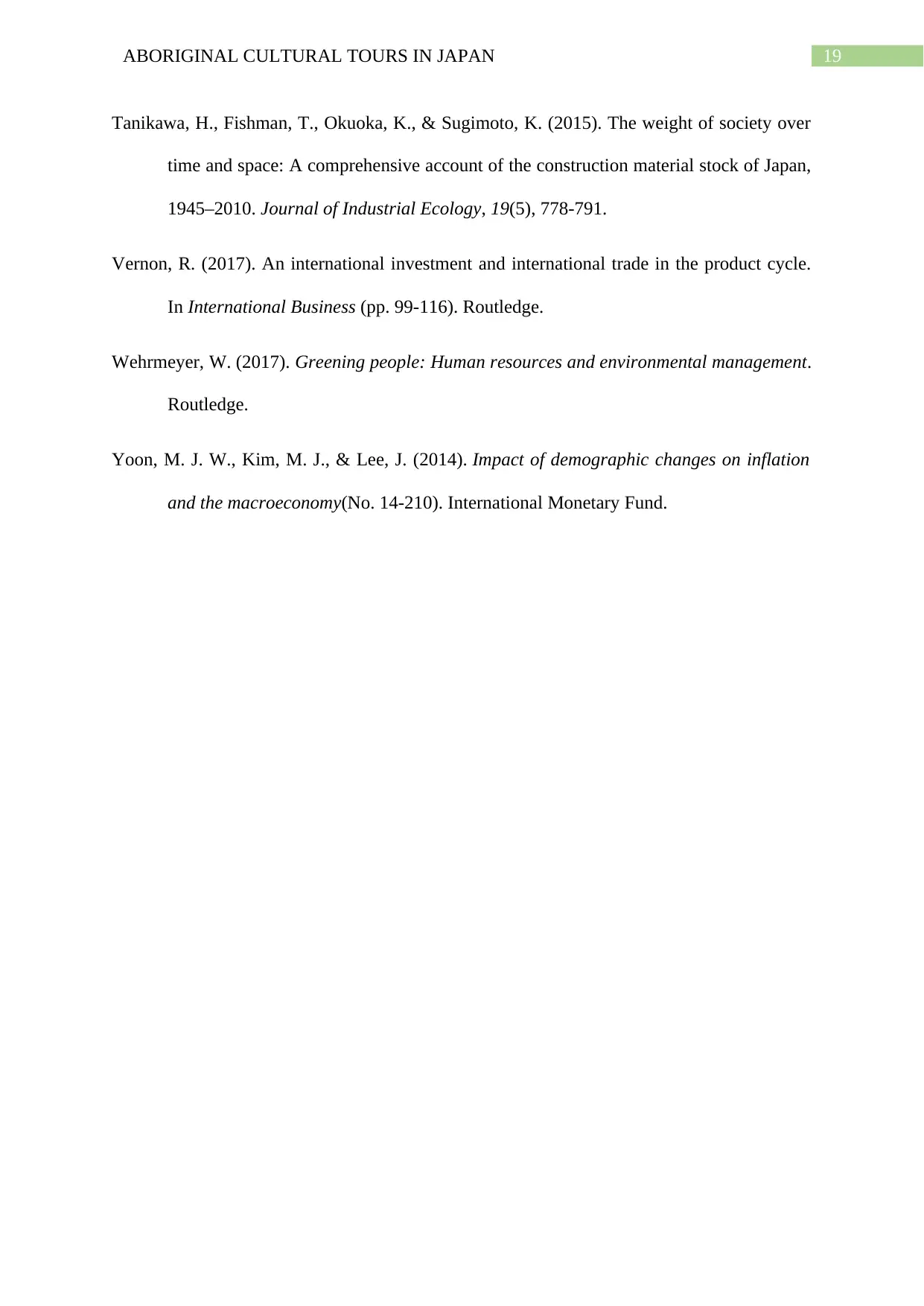
19ABORIGINAL CULTURAL TOURS IN JAPAN
Tanikawa, H., Fishman, T., Okuoka, K., & Sugimoto, K. (2015). The weight of society over
time and space: A comprehensive account of the construction material stock of Japan,
1945–2010. Journal of Industrial Ecology, 19(5), 778-791.
Vernon, R. (2017). An international investment and international trade in the product cycle.
In International Business (pp. 99-116). Routledge.
Wehrmeyer, W. (2017). Greening people: Human resources and environmental management.
Routledge.
Yoon, M. J. W., Kim, M. J., & Lee, J. (2014). Impact of demographic changes on inflation
and the macroeconomy(No. 14-210). International Monetary Fund.
Tanikawa, H., Fishman, T., Okuoka, K., & Sugimoto, K. (2015). The weight of society over
time and space: A comprehensive account of the construction material stock of Japan,
1945–2010. Journal of Industrial Ecology, 19(5), 778-791.
Vernon, R. (2017). An international investment and international trade in the product cycle.
In International Business (pp. 99-116). Routledge.
Wehrmeyer, W. (2017). Greening people: Human resources and environmental management.
Routledge.
Yoon, M. J. W., Kim, M. J., & Lee, J. (2014). Impact of demographic changes on inflation
and the macroeconomy(No. 14-210). International Monetary Fund.
1 out of 20
Related Documents
Your All-in-One AI-Powered Toolkit for Academic Success.
+13062052269
info@desklib.com
Available 24*7 on WhatsApp / Email
![[object Object]](/_next/static/media/star-bottom.7253800d.svg)
Unlock your academic potential
© 2024 | Zucol Services PVT LTD | All rights reserved.




